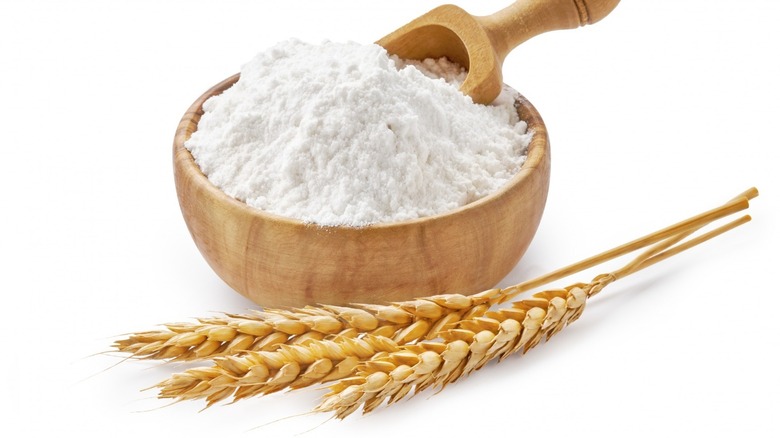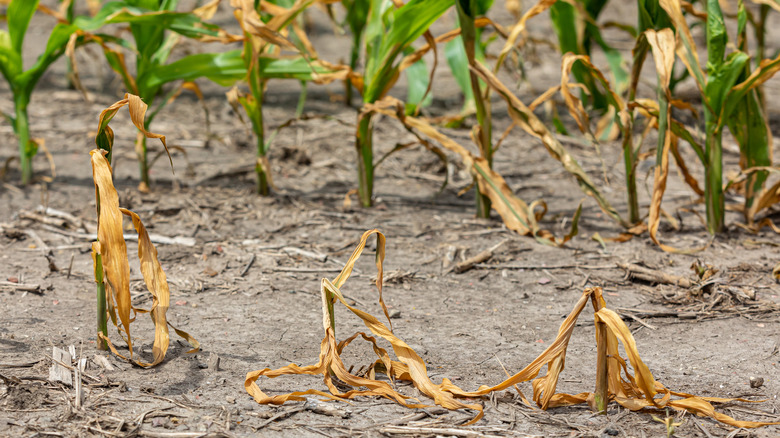How Climate Change Is Majorly Affecting Global Wheat Supplies
It's no secret that food items from snack food to meats and vegetables are more expensive these days, but the reasons why have nothing to do with us and everything to do with the world around us. Thanks to global events from wars to climate change and global supply chain issues, it's no wonder that Kraft Heinz CEO Miguel Patricio said in October that consumers "had to get used to higher food prices," per the BBC.
And he's not alone. Analysts like the agricultural research firm ED&F Man's head of research Kona Haque are sharing this sentiment. "Whether it's corn, sugar, coffee, soybeans, palm oil, you name it, all of these basic food commodities have been rising," Haque has explained, before adding, "Poor harvests in Brazil, which is one of the world's biggest agricultural exporters, drought in Russia, reduced planting in the U.S. and stockpiling in China have combined with more expensive fertilizer, energy, and shipping costs to push prices up.:
With all of these reasons causing food prices to rise, it may feel like there is nothing we can do to combat them. But we must first understand these reasons if we are to survive.
Climate change is hurting crop yields
We probably don't spend too much time thinking about the impact of climate change on agriculture, but we should. As the United States Environmental Protection Agency points out, the agricultural sector puts in more than $300 billion every year, and when other food-related sectors are added to the picture, agriculture and food as a whole contributes in excess of "$750 to the gross domestic product."
University College London professor of resource environmental policy Paul Elkins explains that, while crop grown per hectare has improved over the last five decades, there have been fluctuations over the past 15 years and 30% of fluctuations seen in crop yields were caused by the climate (via The Conversation). He points out that these fluctuations are best seen in certain crops, including barley, maize, millet, pulses, and rice. He also raises the alarm that countries considered to be most exposed to climate change conditions are the same ones who are suffering from food shortages.
Unfavorable growing conditions are already hurting global wheat crops. Bloomberg notes that European farmlands outside of Russia and Ukraine are experiencing warm, dry weather; drought has delayed planting in parts of Canada, too, while scorching heat has damaged wheat crops in India. United Nations Secretary-General António Guterres says that 1.7 billion people have been affected by extreme weather in the last decade alone, per the United Nations. The war on Ukraine is affecting the global food supply, too.
Ironically, Time Magazine adds that the only place wheat crops will deliver a bumper yield is Russia, which is currently waging war on Ukraine.
Global hunger is spiking along with global food prices
Higher food prices don't just mean our money doesn't go as far. It was a somber United Nations Secretary-General António Guterres who opened the Global Food Security Call to Action, and he had an urgent message to share about the global food situation. In a video shared by the organization, Guterres warned diplomats, saying, "Global hunger levels are at a new high. In just two years, the number of severely food insecure people has doubled, from 135 million pre-pandemic to 276 million today."
He adds that the number of people who were living in famine conditions had risen by more than 500% since 2016, and pointed to several factors driving global hunger which were political and natural: Russia's invasion of Ukraine and the COVID-19 pandemic, as well as climate change, which has exposed 1.7 billion people to conditions triggered by "extreme weather and climate-related disasters."
Non-government groups aren't the only ones to be alarmed; the business community is too. James Bolesworth of CRM AgriCommodities says, "If there was ever a year where we needed to see optimum conditions and strong yields around the world, this was going to be it. Clearly, that situation is not being seen. It adds more risk to this highly volatile situation" (via Bloomberg). All of this means that you should expect grocery shortages in 2022 and perhaps beyond if matters don't get better.


